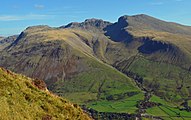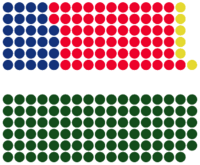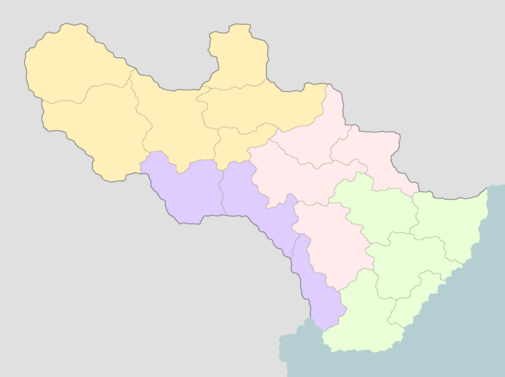Buckland
Buckland Buccalhoan | |
|---|---|
| Capital | Dunhelm |
| Official languages | Buckish |
| Recognised national languages | Swathish Gaullican |
| Religion | |
| Demonym(s) | Bucklander |
| Government | Unitary semi-presidential republic |
| Privy Council' | |
• Premier | Moake Kneale |
| Legislature | Heousdhing |
| Area | |
• | 90,443 km2 (34,920 sq mi) |
| Population | |
• 2016 estimate | 6,825,000 |
• Density | 75/km2 (194.2/sq mi) |
| GDP (PPP) | $363 billion estimate |
• Per capita | $53,186 |
Buckland (Buckish: Buccalhoan) is a sovereign nation in Kylaris. Located in Euclea, it lies on the north-eastern coast of the Euclean mainland and is bordered by Estmere to the south and Werania to the west. The capital and largest city is Dunhelm, whose metropolitan area is home to around a seventh of the country's 6.8 million inhabitants. The legislature, consists of a unicameral chamber, the Heousdhing. The head of state and government is the Premier, who is elected by the Heousdhing, the Premier in turn appoints other government ministers.
Etymology
The name "Buckland" is derived from the Buckish name Buccalond, of which there are two possible meanings. The first, is that it derives from the semi-legendary figure Bucca, an Old Swathish warlord controlling modern day Newstedschir, and was chosen by Leofƿine Osƿinson, the first king of a united Buckland. As the name Buckland first appears in the Venerable Seofeca's Lives of Northern Saints. The second, and less accepted folk etymology, is that it derives from Buc, and is a reference to the large amount of deer present in the area.
The area has historically been known as the Northmarch (Buckish: Nordhmerch), particularly in Estmere where the area was often regarded as a province. Today, except in certain contexts, this is considered derogatory as it insinuates a lack of sovereignty and separate identity of Bucklanders from the Estmerish and Swathish peoples.
History
Background
<imgur thumb="yes" w="200" comment="King Aethelmod of y receiving an oath of loyalty from Morcar the Wake.">M9kwfdp.jpg</imgur>Settlement by anatomically modern humans of what was to become Buckland occurred in waves beginning by about 30,000 years ago. By the end of the region's prehistoric period, the population is thought to have belonged, in the main, to a culture termed Continental Tenic. The Solarian conquest, beginning in x AD, and the ensuing x-year rule, was followed by the migration of Weranic Estmero-Ruttish settlers into the area, reducing the Cwinerish people mainly to what was to become Cwinearscir.
During the settlement period the lands ruled by the incomers seem to have been fragmented into numerous tribal territories, but by the 7th century, when substantial evidence of the situation again becomes available, these had coalesced into roughly a dozen kingdoms based on old tribal affiliations. The 7th century saw a struggle for hegemony between x, w and z, which in the 8th century gave way to w preeminence. In the early 9th century w was displaced as the foremost kingdom by the southern kingdom of y.

In the mid-10th century, Verique lords conquered Estmere and Buckland, consolidating it into the Kingdom of Embria. In the south, this conquest led to the almost total dispossession of the Swathish elite and its replacement by a new Flurian-speaking aristocracy, whose speech had a profound and permanent effect on the Estmerish language. In Buckland, however, the local elite had aided the Verique conquest of the kingdom of y, and faced little replacement or dispossession, and largely governed the newly made Northmarch province for their Verique overlords.
Independence
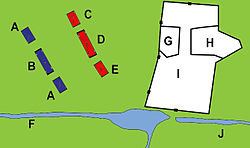
The outbreak of the Anarchy in 1189 saw the local nobility of Buckland support the revolt of Cedric Cynricson, pledging their forces to him. The Black Supper decimated the prominent landholders of Buckland, with Maethelgar Wachefet and Scenwulf Scenwulfsun among the slain. At the Blōdmōt, the nobility supported Cedric's daughter Ealdgyth, though her peace deal with Embria saw infighting break out amongst the Swathish and Bucklanders. Fearing that their revolt had undermined their previous position, representatives from each shire hastily declared Leofwine Oswinson, a minor thane and veteran of the Anarchy, as king of Buckland (Buccalond Cyning). Embrian attempts to quell the revolt were initially successful, defeating Leofwine in the battles of Bencumb and Burm, but their largely Swathish force led by Tancreid, Earl of x, was summarily defeated at the Battle of Dunhelm, with Tancreid taken prisoner. The outbreak of the Count's Revolt saw no further Embrian invasion, with Leofwine taking the initiative to ally with the revolting nobles.
Following the Declaration of Dercylm, Buckland maintained its independence, albeit in near-constant conflict with Estmere. The Bucklander monarchs, through ties to the Swathish people and their claims to the Weald, were also heavily in conflict with the counts of the Weald throughout this period. The deposition of Turec II in 1376 by the Witan saw the last serious Estmerish attempt to reconquer Buckland, the war being ended with the Treaty of Ashcombe and the accession of Goldwine III, a member of the House of Litwinson. They reigned for two centuries, some noted monarchs being Godmund II, Ceolred I and Ēomer II. The period saw changes in trade and legislation, with the cities of Dumnhelm and Gaunt doubling in size and becoming regional centres of commerce. Catholic monasticism flourished, providing philosophers, and the universities of Bencumb and King's Dunhelm were founded with royal patronage.
From 1526 to 1533 a civil war occurred between two branches of the royal family – the senior Cynwulfing and the junior Hunwalding - over the late Asulf's chosen successor. Eventually it led to the Cynwulfing losing the throne entirely to the the Hunwaldings, headed by Saewynn I and her husband Richard Vernon who invaded with Swathish and Flurian mercenaries, gaining victory at the Battle of Hēth where the Cynwulfing king Beric III was captured and deposed.
Union with Estmere
The Great War
Modern Day
Geography
Much of Buckland consists of rolling hills and plains. The west is generally more mountainous with a chain of mountains, the Cæradun Hills, dividing Rægdellscir and Cƿinearscir from Estmere and Werania in the south and the north and west respectively, and containing the highest mountains in the country. Other upland and hilly areas in the north-west, north, and south-east are the Helmann Hills, the Carn Moors, and the Ċiltern Hills respectively.
The western River Studeƿeter and midland River Loƿca both feed into River Bencumb, which demarcates much of the Buckland-Estmere border, and is fed by the Cæradun Hills. The north-eastern River Escc feeds directly into the Gulf of Assonaire, while the north-western River Mēte feeds into Lake Dudonne, and then drains into Werania.
Buckland has a temperate climate, with plentiful rainfall all year round. The temperature varies with the seasons seldom dropping below −11 °C or rising above 35 °C. The prevailing wind is from the north-east and bears frequent spells of mild and wet weather from the Florian Ocean, although the western parts are mostly sheltered from this wind as the majority of the rain falls over the eastern regions, making the western parts therefore the driest.
Rūhtor in Cƿinearscir, the highest point in Buckland
Part of the Cæradun Hills in Rægdellscir
Part of Lake Dudonne in Hamafuntascir
The rolling plains near Ƿendofer
Part of the Ċiltern Hills in Bencumbscir
A stretch of the River Bencumb, near Axanheall
Politics
Government
Since 1936 the country has been a unitary republic, with this enshrined in the Constitution of the Realm, the Ehric Amendment, and the Bencumbe Declaration, which states that Buckland "shall be a state in the common trust, to be governed responsibly in the interests of all Bucklanders." The government is divided into three branches, the executive, legislative, and judicial branches, with each of their roles and responsibilities being defined by the Constitution.
The head of state and government, supreme governor of the Church of Buckland, and commander-in-chief of the armed forces is the Premier (Kionard). The Premier serves as the head of the executive. Most Premiers have served as the leader of the political party that gains the most seats in national elections. Coalitions are common, with the 2017 election producing the first majority government since 2001. Moake Kneale is the current Premier and is the leader of the Coodh party. He has served as Premier since the 2017 general election. Likewise, the Premier nominates candidates to fill all ministerial posts. All cabinet ministers must be sitting vitan and serve at the pleasure of the Premier. Ministers (embitmans) oversee the various ministries.
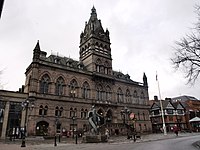 |
|
Government (101) Coodh (101) Opposition (99) Raskail (63) Kurnee (28) Robunkshough (6) Tosomme (2) |
The Heousdhing is the national legislature and is unicameral. It has 200 members known as vitan (Sg. vita) who are elected via three methods: 100 are elected by single transferable vote and represent a single constituency (dhrideen), 64 are elected through open-list proportional representation and represent one of four farthings (fardeen), while the last 18 are appointed by the shire assemblies, 2 per each. vitan serve a maximum five year term and then it is mandated by the Constitution that fresh elections must be held. Snap elections may be held between the regularly scheduled elections at the discretion of the Premier, who also decides date of the election so long as it is not 45 days after the dissolution of the Heousdhing. Currently the Coodh party form a majority government.
Coodh, Kurnee and Raskail have, since the institution of the Heousdhing, been considered Buckland's three major political parties, broadly representing conservatism, liberalism and social democracy, respectively. the remaining seats were won by minor parties. From 1938 to 2001, in accordance with previous party policy, no elected Robunkshough witan had ever attended the Heousdhing to speak on behalf of their constituents because of the requirement to take an oath to defend the institutions of the republic, though they did not abstain from local assemblies or the EC where such an oath is absent. The terms of the oath were changed in 2001 to allow the replacement of the word 'republic' with 'Buckland'.
Each shire has their own local government and executive, led by a Sheriff (shreeve) , and a devolved unicameral legislature, the Shiremoot (schirmote), and each farthing has a directly elected governor (steren), whose position is largely ceremonial. The Shiremoots have wide-ranging powers over any matter that has not been specifically reserved to the Heousdhing, including education, healthcare, law, and local government. Under the doctrine of parliamentary sovereignty enshrined in the Constitution, the Heousdhing has the power to abolish, either temporarily or permanently, any of the Shiremoots, though this power remains unused.
Bucklander law is based on common-law principles. The essence of common law is that, subject to statute, the law is developed by judges in courts, applying statute, precedent and common sense to the facts before them to give explanatory judgements of the relevant legal principles, which are reported and binding in future similar cases. The Supreme Court (Big Stalern) is the highest court in the land for both criminal and civil appeal cases in Buckland and any decision it makes is binding on every other court in the same jurisdiction. As Buckland is a member of the Euclean Community, it is possible for appeal cases to go beyond the Supreme Court to the Euclean Court of Justice.
Foreign Relations and Military
Administrative Divisions
The organisation of local government in Buckland is complex, with the distribution of functions varying according to local arrangements. The upper-tier subdivisions of Buckland are the four regions known as Farthings (Ffeorðingas), used primarily in the secondary method of electing Ƿitan. Since 1984 each farthing has had a directly elected governor (steorend), following popular support for the proposal in a referendum.
Below the regional tier are the shires (scire), which have a directly elected assembly (scirmūt) and sheriff (sċīrġerēfa). The assemblies have the power to legislate in all areas that are not explicitly reserved to the Ƿitanegamot. All matters that are not specifically reserved are automatically devolved to the assemblies. Most importantly, this includes agriculture, fisheries and forestry, economic development, areas of education, environment, food standards, consumer advocacy, health, home affairs, courts, legal profession, police and fire services, prisons, local government, sport and the arts, transport, road signs, speed limits, rail franchising, training, tourism, research and statistics, social work and various welfare and housing related benefits.
Each shire is divided into hundreds, which act as both electoral constituencies and areas for local government. Hundreds are differentiated between metropolitan (hundburh) and non-metropolitan (hundƿīc), with metropolitan local councils tending to have more powers and responsibilities. Like shires, each hundred has a directly elected council (hundmūt) and representative (hundġerēfa), and operate a variety of functions including education (schools and youth services), social services, highways, fire and rescue services, libraries, waste disposal, consumer services and town and country planning.
Demographics
A census is taken simultaneously in all parts of Buckland every ten years. In the 2016 census the total population of Buckland was 6,825,571. Among other nations, tt is the third-smallest in the Euclean Community, and the 6th-smallest in the world. Between 2006 and 2016 the population increased by an average annual rate of approximately 0.9%. This compares to 1.1% per year in the period 1991 to 2001 and 1.4% in the decade 1981 to 1991. The 2016 census also confirmed that the proportion of the population aged 0–14 has nearly halved (39% in 1911 compared to 22% in 2011) and the proportion of older people aged 65 and over has more than doubled (from 4 to 11%).
It is one of the least densely populated countries in the world, with x people resident per square kilometre in 2016. The population is largely concentrated in the south, along the Bencombe River, and in the capital, Dunhelm. In 2014 the average total fertility rate across Buckland was 2.45 children per woman, with 11.6% of births to unmarried women, which is above 2011's rate of 9.4% but below the peak of 21.6% in 2003.
Ethnic Groups
Indigenous Bucklander people are thought to be descended from the various ethnic groups that settled there before the 11th century: the pre-Tenic neolithic settlers, Tenics and the Old Swathish. A 2001 genetic study showed that more than 40% of Buckland's gene pool contains Y chromosomes usually found in Weranic peoples. A later 2012 genetic analysis indicates that "about 65% of the traceable ancestors of the modern Bucklander population had arrived in Buckland by about 6,200 years ago, at the start of the Estmerish Neolithic or Stone Age".
The Bucklander people are a nation and an ethnic group native to Buckland who speak the Buckish language. They are related to the peoples of Estmere, being considered part of the wider Swathish peoples, but are differentiated via their distinct language and customs, though over many centuries of shared history, Bucklander customs and identity became fairly closely aligned with Estmerish customs and identity in general, though since 1935 there has been a strong desire to develop their own separate and distinct national identity. Today, the overwhelming majority of Bucklanders do not identify as Swathish or Estmerish.
Buckland has a history of small-scale non-white immigration, with Gaunt having the oldest Black population in the country dating back to at least the 1730s during the height of the Bahian slave trade. In 1950 there were probably fewer than 10,000 non-white residents in Buckland, almost all born overseas. In 1986 there were an estimated 44,000 people living in Buckland with ancestry from Badawiyah, Coius, Bahia, and the Arucian, just under 0.3% of the population. By 2016 this number had more than doubled to 90,000, just about 1% of the population.
Languages
The Bucklander language, Buckish, is descended from Old Swathish and is the national language of Buckland, where it remains the principal tongue spoken natively by 97% of the population. It is a Hyndo-Euclean language in the Estmero-Ruttish branch of the Weranic family. After the Verique conquest of Estmere, the Old Swathish language was largely displaced and confined to the lower social classes as Verique Gaullican and Solarian were used by the aristocracy, while in Buckland it remained largely untouched.
Buckish grammar is typical of Hyndo-Euclean dependent marking pattern with a rich inflectional morphology and relatively free word order, compared to its mutually unintelligible relatives Swathish and Estmerish with their mostly analytic pattern with little inflection, a fairly fixed SVO word order and a complex syntax. Despite Buckland's relatively small size, there are many distinct regional accents, and individuals with particularly strong accents may not be easily understood everywhere in the country.
As well as Buckish, Buckland has one other indigenous language, Cwinerish (Buckish: Cƿinearisc; Cwinerish: Gwynnyerek). Cwinerish died out as a community language in the 17th century but is being revived, and is now protected under the Euclean Charter for Minority Indigenous Languages. It is spoken as a secondary language by 4% of people in Cƿinearscir, and is taught to some degree in several primary and secondary schools.
State schools are required to teach students a second language, usually Gaullican, Weranic or Estmerish. Due to increased immigration, it was reported in 2003 that around 30,000 school students spoke a foreign language at home, the most common being Gaullican. However, following the 2016 census data, figures now show that Estmerish is the main language spoken in Buckland after Buckish.
Religion
Religion in the Buckland (2016 Census)
Forms of Sotirianity have dominated religious life in Buckland for over 1400 years. Although a majority of citizens still identify with Sotirianity in many censuses, regular church attendance has fallen substantially since the middle of the 20th century, and after 1951 citizenship no longer required one to be Sotirian. This has led some commentators to describe Buckland as gradually becoming a secular and multi-faith society.
The Church of Buckland is the established church in Buckland. After the 1986 Heousdhing Reform Act, the five seats reserved for bishops were abolished, though the office of the President acts as the Supreme Head of the Church. In a 2016 survey on religious affiliation; 95% of respondents indicated they were Sotirians, followed by 4% who said they had no-religion, and 1% who affiliated with other religions (e.g. Salam, Atudism, Hyndism, etc.). Among Sotirians, adherents to the Church of Buckland constituted 91%, Solarian Catholic Church – 3%, other Sotirians (including Kasperist, Videteurs, other Amendists, as well as Western Orthodox) – 1%
A survey in 2007 showed only two in ten Bucklanders actually attend church weekly. Between the 2006 and 2016 census there was a decrease in the number of people who identified as Sotirian by 2%, whilst the percentage of those reporting no religious affiliation doubled.
Urbanisation
The Greater Dunhelm Urban Area is by far the largest urban area in Buckland, and among the larger cities in Eastern Euclea. It is considered an important regional city within the EC, and is the primary financial and governmental hub witihn Bucklan. Other urban areas of considerable size and influence tend to be in the south, along the Bencumb River, or the south-eastern coast. While many cities in Buckland are quite large, such as Gaunt, Axanheall, Nīwested and Bencumb, population size is not a prerequisite for city status. Traditionally the status was given to towns with diocesan cathedrals, so there are smaller cities like Acum, Mēġdenhyðe, Bēacenfeld, and Tīƿing.
Largest cities or towns in Buckland
2016 census | |||||||||
|---|---|---|---|---|---|---|---|---|---|
| Rank | Shire | Pop. | Rank | Shire | Pop. | ||||
 Dunhelm  Gaunt |
1 | Dunhelm | Cyrescir | 975,438 | 11 | Cgyrƿum | Norðhberetunscir | 43,431 |  Axanheall  Nīƿested |
| 2 | Gaunt | Bencumbscir | 311,678 | 12 | Calferheall | Suðberetunscir | 38,521 | ||
| 3 | Axanheall | Axanheallscir | 180,456 | 13 | Acum | Acumscir | 35,476 | ||
| 4 | Nīƿested | Nīƿestedscir | 154,543 | 14 | Hamafunta | Hamafuntascir | 32,106 | ||
| 5 | Bencumb | Bencumbscir | 137,821 | 15 | Cƿinear | Cƿinearscir | 29,453 | ||
| 6 | Carhærac | Carhæracscir | 112,132 | 16 | Tīƿing | Tīƿingscir | 22,510 | ||
| 7 | Alneċeaster | Alneċeasterscir | 84,356 | 17 | Mēġdenhyðe | Bencumbscir | 21,346 | ||
| 8 | Hēah Ƿicumun | Bencumbscir | 76,921 | 18 | Hælesƿerþ | Cyrescir | 18,560 | ||
| 9 | Þƿēt | Þƿētscir | 56,984 | 19 | Rægdell | Rægdellscir | 15,632 | ||
| 10 | Geatford | Geatfordscir | 52,346 | 20 | Sceldun | Sceldunscir | 14,623 | ||



